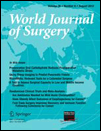Open Abdomen Treatment with Dynamic Sutures and Topical Negative Pressure Resulting in a High Primary Fascia Closure Rate
Abstract
Background
Open abdomen (OA) treatment with negative-pressure therapy is a novel treatment option for a variety of abdominal conditions. We here present a cohort of 160 consecutive OA patients treated with negative pressure and a modified adaptation technique for dynamic retention sutures.
Methods
From May 2005 to October 2010, a total of 160 patients—58 women (36 %); median age 66 years (21–88 years); median Mannheim peritonitis index 25 (5–43) underwent emergent laparotomy for diverse abdominal conditions (abdominal sepsis 78 %, ischemia 16 %, other 6 %).
Results
Hospital mortality was 21 % (13 % died during OA treatment); delayed primary fascia closure was 76 % in the intent-to-treat population and 87 % in surviving patients. Six patients required reoperation for abdominal abscess and five patients for anastomotic leakage; enteric fistulas were observed in five (3 %) patients. In a multivariate analysis, factors correlating significantly with high fascia closure rate were limited surgery at the emergency operation and a Björk index of 1 or 2; factors correlating significantly with low fascia closure rate were male sex and generalized peritonitis.
Conclusions
With the aid of initially placed dynamic retention sutures, OA treatment with negative pressure results in high rates of delayed primary fascia closure. OA therapy with the technical modifications described is thus considered a suitable treatment option in various abdominal emergencies.




